

>80% relative improvement in patient response; 71% vs 39% complete sUA response* compared to KRYSTEXXA alone during Month 61
87% relative reduction in infusion reactions; 4% vs 31% compared to KRYSTEXXA alone1
With fewer infusion reactions and improved patient response, you can confidently reduce years of urate burden1

Managing your uncontrolled gout can involve a lot of moving parts. Amgen By Your Side is a support program for patients prescribed KRYSTEXXA. Our dedicated team is your patient’s partner, committed to providing nonmedical support so they can start and continue on treatment as you prescribe.
The KRYSTEXXA team is available to share more about the systemic nature of uncontrolled gout.
Uncontrolled gout is a chronic and systemic disease that affects patients beyond the joints.3,4
Gout Flares: An increase in gout flares is frequently observed upon initiation of anti-hyperuricemic therapy, including KRYSTEXXA. Gout flare prophylaxis with a non-steroidal anti-inflammatory drug (NSAID) or colchicine is recommended starting at least 1 week before initiation of KRYSTEXXA therapy and lasting at least 6 months, unless medically contraindicated or not tolerated.
Congestive Heart Failure: KRYSTEXXA has not been formally studied in patients with congestive heart failure, but some patients in the pre-marketing placebo-controlled clinical trials experienced exacerbation. Exercise caution in patients who have congestive heart failure and monitor patients closely following infusion.
The most commonly reported adverse reactions (≥5%) are:
KRYSTEXXA co-administration with methotrexate trial:
KRYSTEXXA with methotrexate: gout flares, arthralgia, COVID-19, nausea, and fatigue; KRYSTEXXA alone: gout flares, arthralgia, COVID-19, nausea, fatigue, infusion reaction, pain in extremity, hypertension, and vomiting.
KRYSTEXXA pre-marketing placebo-controlled trials:
gout flares, infusion reactions, nausea, contusion or ecchymosis, nasopharyngitis, constipation, chest pain, anaphylaxis, and vomiting.
KRYSTEXXA® (pegloticase) is indicated for the treatment of chronic gout in adult patients who have failed to normalize serum uric acid and whose signs and symptoms are inadequately controlled with xanthine oxidase inhibitors at the maximum medically appropriate dose or for whom these drugs are contraindicated.
Limitations of Use: KRYSTEXXA is not recommended for the treatment of asymptomatic hyperuricemia.
Please see Full Prescribing Information, including Boxed Warning.